Spectral Mapping Techniques for the Stratigraphic and Compositional Characterisation of a 16th-Century Painting
Abstract
1. Introduction
2. Materials and Methods
2.1. Case Study
2.2. Reference Samples
2.3. SEM-EDS
2.4. Macro-Scanning X-ray Fluorescence Mapping (MA-XRF)
2.5. Reflectance Imaging Spectrosocpy (RIS)
Spectral Correlation Mapping (SCM)
3. Results
3.1. Elemental Analysis
3.2. Spectral Correlation Mapping (SCM)
4. Discussion
5. Conclusions
Supplementary Materials
Author Contributions
Funding
Data Availability Statement
Acknowledgments
Conflicts of Interest
References
- de Viguerie, L.; Glanville, H.; Radepont, M.; Cerasuolo, A.; Rullo, A.; Seccaroni, C.; Walter, P. An investigation of Bellini’s Transfiguration in the Capodimonte museum by means of XRF and visible reflectance hyperspectral imaging: Bellini’s handling of materials in the head and figure of the transfigured Christ. Herit. Sci. 2023, 11, 163. [Google Scholar] [CrossRef]
- Brocchieri, J.; Scialla, E.; D’Onofrio, A.; Sabbarese, C. Combining XRF, Multispectral Imaging and SEM/EDS to Characterize a Contemporary Painting. Quantum Beam Sci. 2023, 7, 13. [Google Scholar] [CrossRef]
- Alfeld, M. MA-XRF for Historical Paintings: State of the Art and Perspective. Microsc. Microanal. 2020, 26, 72–75. [Google Scholar] [CrossRef]
- de Almeida Nieto, L.M.; Gabrieli, F.; van Loon, A.; Gonzalez, V.; Dik, J.; Van de Plas, R.; Alfeld, M. Comparison of macro x-ray fluorescence and reflectance imaging spectroscopy for the semi-quantitative analysis of pigments in easel paintings: A study on lead white and blue verditer. X-ray Spectrom. 2023. [Google Scholar] [CrossRef]
- Cucci, C.; Delaney, J.K.; Picollo, M. Reflectance hyperspectral imaging for investigation of works of art: Old master paintings and illuminated manuscripts. Acc. Chem. Res. 2016, 49, 2070–2079. [Google Scholar] [CrossRef] [PubMed]
- Dong, Y.; Du, B.; Zhang, L.; Zhang, L. Dimensionality reduction and classification of hyperspectral images using ensemble discriminative local metric learning. IEEE Trans. Geosci. Remote Sens. 2017, 55, 2509–2524. [Google Scholar] [CrossRef]
- Richards, J.A. Richards. In Remote Sensing Digital Image Analysis, 3; Springer: Berlin, Germany, 1999; pp. 10–38. [Google Scholar]
- Grabowski, B.; Masarczyk, W.; Głomb, P.; Mendys, A. Automatic pigment identification from hyperspectral data. J. Cult. Herit. 2018, 31, 1–12. [Google Scholar] [CrossRef]
- Deborah, H.; George, S.; Hardeberg, J.Y. Pigment mapping of the scream (1893) based on hyperspectral imaging. In International Conference on Image and Signal Processing; Springer: Cham, Switzerland, 2014; pp. 247–256. [Google Scholar]
- Schreiner, M.; Melcher, M.; Uhlir, K. Scanning electron microscopy and energy dispersive analysis: Applications in the field of cultural heritage. Anal. Bioanal. Chem. 2007, 387, 737–747. [Google Scholar] [CrossRef]
- Irazola, M.; Olivares, M.; Castro, K.; Maguregui, M.; Martínez-Arkarazo, I.; Madariaga, J.M. In situ Raman spectroscopy analysis combined with Raman and SEM-EDS imaging to assess the conservation state of 16th century wall paintings. J. Raman Spectrosc. 2012, 43, 1676–1684. [Google Scholar] [CrossRef]
- Morello, M. Il Restauro del Dipinto su Tavola “Sacra Famiglia con San Giovannino e Santa Elisabetta” Attribuito a Domenico Beceri: Una Complessa Storia d’Esecuzione e di Conservazione. Trattamento dei Residui Cerosi e Ricerca sulla Compatibilità dei Materiali per l’Integrazione Materica. Master’s Thesis, Rel. Coord. C. Toso, Scuola di Alta Formazione e Studio (SAFS) Opificio delle Pietre Dure, Firenze, Italy, 2022. [Google Scholar]
- Aldrovandi, A.; Altamura, M.L.; Cianfanelli, M.T.; Riitano, P. I Materiali Pittorici: Tavolette Campione Per La Caratterizzazione Mediante Analisi Multispettrale. OPD Restauro 1996, 8, 101–103, 191–210. Available online: http://www.jstor.org/stable/24395397 (accessed on 24 February 2024).
- CHNet—Cultural Heritage Network. Available online: https://chnet.infn.it (accessed on 10 August 2022).
- Taccetti, F.; Castelli, L.; Czelusniak, C.; Gelli, N.; Mazzinghi, A.; Palla, L.; Ruberto, C.; Censori, C.A.; Lo Giudice, A.; Re, D.; et al. A multipurpose X-ray fluorescence scanner developed for in situ analysis. Rend. Lincei. Sci. Fis. E Nat. 2019, 30, 307–322. [Google Scholar] [CrossRef]
- Striova, J.; Dal Fovo, A.; Fontana, R. Reflectance imaging spectroscopy in heritage science. Riv. Nuovo C. 2020, 43, 515–566. [Google Scholar] [CrossRef]
- Striova, J.; Ruberto, C.; Barucci, M.; Blažek, J.; Kunzelman, D.; Dal Fovo, A.; Pampaloni, E.; Fontana, R. Spectral imaging and archival data in analysing Madonna of the Rabbit paintings by Manet and Titian. Angew. Chem. 2018, 130, 7530–7534. [Google Scholar] [CrossRef]
- Mandal, D.J.; Pedersen, M.; George, S.; Deborah, H.; Boust, C. An experiment-based comparative analysis of pigment classification algorithms using hyperspectral imaging. J. Imaging Sci. Technol. 2023, 67, 30403–30418. [Google Scholar] [CrossRef]
- De Carvalho, O.A.; Meneses, P.R. Spectral correlation mapper (SCM): An improvement on the spectral angle mapper (SAM). In Summaries of the 9th JPL Airborne Earth Science Workshop, JPL Publication 00-18; JPL Publication: Pasadena, CA, USA, 2000; Volume 9, p. 2. [Google Scholar]
- Lalli, C.G.; Innocenti, F. Tecniche artistiche di dipinti su tavola dal XII al XVI secolo. OPD Restauro 2015, 27, 309–322. Available online: http://www.jstor.org/stable/44627776 (accessed on 24 February 2024).
- Ricciardi, P.; Mazzinghi, A.; Legnaioli, S.; Ruberto, C.; Castelli, L. The choir books of San Giorgio Maggiore in Venice: Results of in depth non-invasive analyses. Heritage 2019, 2, 1684–1701. [Google Scholar] [CrossRef]
- Zucchiatti, A.; Bouquillon, A.; Katona, I.; D’Alessandro, A. The ‘della Robbia blue’: A case study for the use of cobalt pigments in ceremics during the Italian Renaissance. Archaeometry 2006, 48, 131–152. [Google Scholar] [CrossRef]
- Giovanni, C.; Riccardi, M.P. Glass-based pigments in painting: Smalt blue and lead–tin yellow type II. Archaeol. Anthropol. Sci. 2021, 13, 199. [Google Scholar]
- Coccato, A.; Moens, L.; Vandenabeele, P. On the stability of mediaeval inorganic pigments: A literature review of the effect of climate, material selection, biological activity, analysis and conservation treatments. Herit. Sci. 2017, 5, 12. [Google Scholar] [CrossRef]
- Pottasch, C.; van Loon, A.; Haswell, R. Analysing the influence of lead white on smalt degradation in three paintings by Pellegrini, using SEM-EDX quantitative mapping. In Proceedings of the 4th International Congress Chemistry for Cultural Heritage, Brussels, Belgium, 5–9 July 2016; p. 70. [Google Scholar]
- Vitorino, T.; Casini, A.; Cucci, C.; Melo, M.J.; Picollo, M.; Stefani, L. Non-invasive identification of traditional red lake pigments in fourteenth to sixteenth centuries paintings through the use of hyperspectral imaging technique. Appl. Phys. A 2015, 121, 891–901. [Google Scholar] [CrossRef]
- Stanzani, E.; Bersani, D.; Lottici, P.P.; Colomban, P. Analysis of artist’s palette on a 16th century wood panel painting by portable and laboratory Raman instruments. Vib. Spectrosc. 2016, 85, 62–70. [Google Scholar] [CrossRef]
- Aceto, M.; Agostino, A.; Fenoglio, G.; Idone, A.; Gulmini, M.; Picollo, M.; Delaney, J.K. Characterisation of colourants on illuminated manuscripts by portable fibre optic UV-visible-NIR reflectance spectrophotometry. Anal. Methods 2014, 6, 1488–1500. [Google Scholar] [CrossRef]
- Dal Fovo, A.; Mattana, S.; Ruberto, C.; Castelli, L.; Ramat, A.; Riitano, P.; Fontana, R. Novel integration of non-invasive imaging techniques for the analysis of an egg tempera painting by Pietro Lorenzetti. Eur. Phys. J. Plus 2023, 138, 71. [Google Scholar] [CrossRef]
- Colantonio, C.; Clivet, L.; Laval, E.; Coquinot, Y.; Maury, C.; Melis, M.; Boust, C. Integration of multispectral imaging, XRF mapping and Raman analysis for noninvasive study of illustrated manuscripts: The case study of fifteenth century “Humay meets the Princess Humayun” Persian masterpiece from Louvre Museum. Eur. Phys. J. Plus 2021, 136, 958. [Google Scholar] [CrossRef]
- Duncan, D.R. The colour of pigment mixtures. Proc. Phys. Soc. 1940, 52, 390–401. [Google Scholar] [CrossRef]
- Kleynhans, T.; Messinger, D.W.; Delaney, J.K. Towards automatic classification of diffuse reflectance image cubes from paintings collected with hyperspectral cameras. Microchem. J. 2020, 157, 104934. [Google Scholar] [CrossRef]
- Valero, E.M.; Martínez-Domingo, M.A.; López-Baldomero, A.B.; López-Montes, A.; Abad-Muñoz, D.; Vílchez-Quero, J.L. Unmixing and pigment identification using visible and short-wavelength infrared: Reflectance vs. logarithm reflectance hyperspaces. J. Cult. Herit. 2023, 64, 290–300. [Google Scholar] [CrossRef]
- Chaudhry, F.; Wu, C.C.; Liu, W.; Chang, C.I.; Plaza, A. Pixel purity index-based algorithms for endmember extraction from hyperspectral imagery. Recent Adv. Hyperspect. Signal Image Process. 2006, 37, 29–62. [Google Scholar]
- Borsoi, R.A.; Imbiriba, T.; Bermudez, J.C.M. Deep generative endmember modeling: An application to unsupervised spectral unmixing. IEEE Trans. Comput. Imaging 2019, 6, 374–384. [Google Scholar] [CrossRef]
- Borsoi, R.A.; Imbiriba, T.; Closas, P. Dynamical Hyperspectral Unmixing with Variational Recurrent Neural Networks. IEEE Trans. Image Process. 2023, 32, 2279–2294. [Google Scholar] [CrossRef]
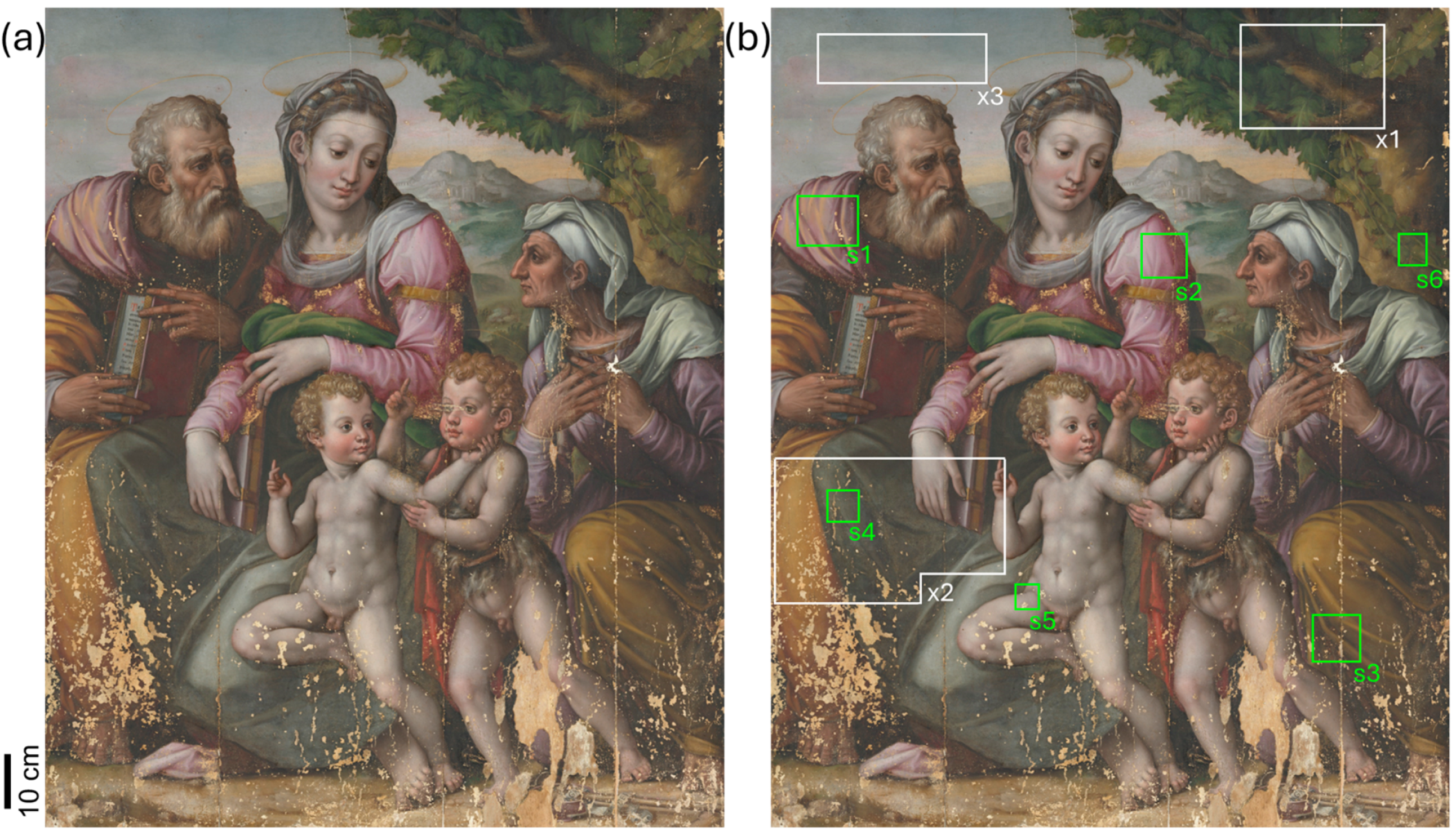
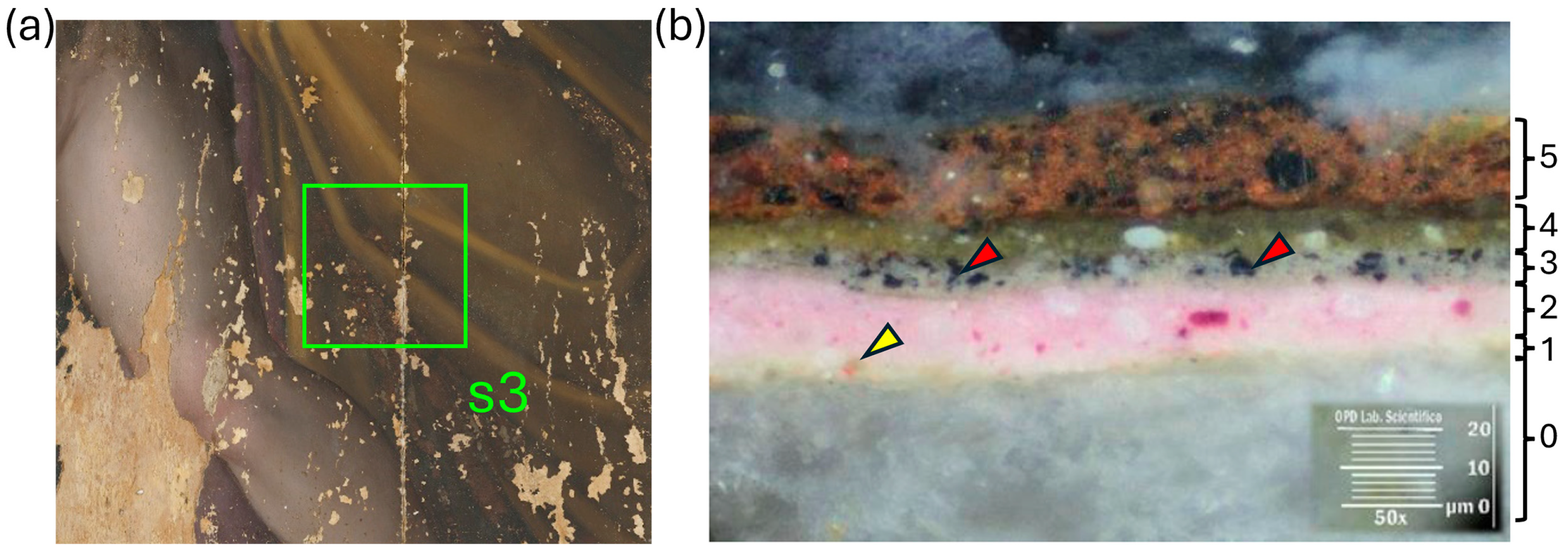
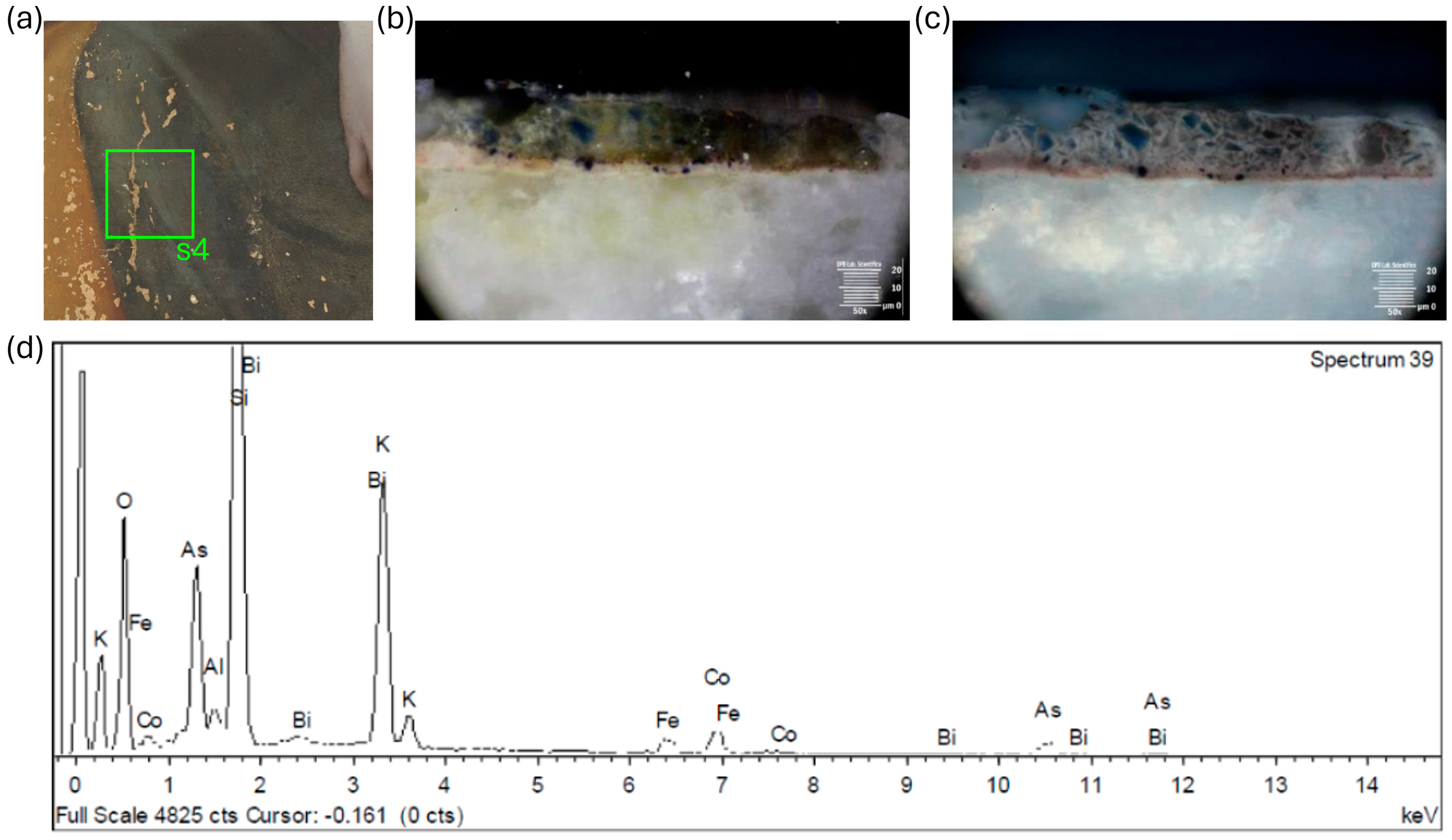

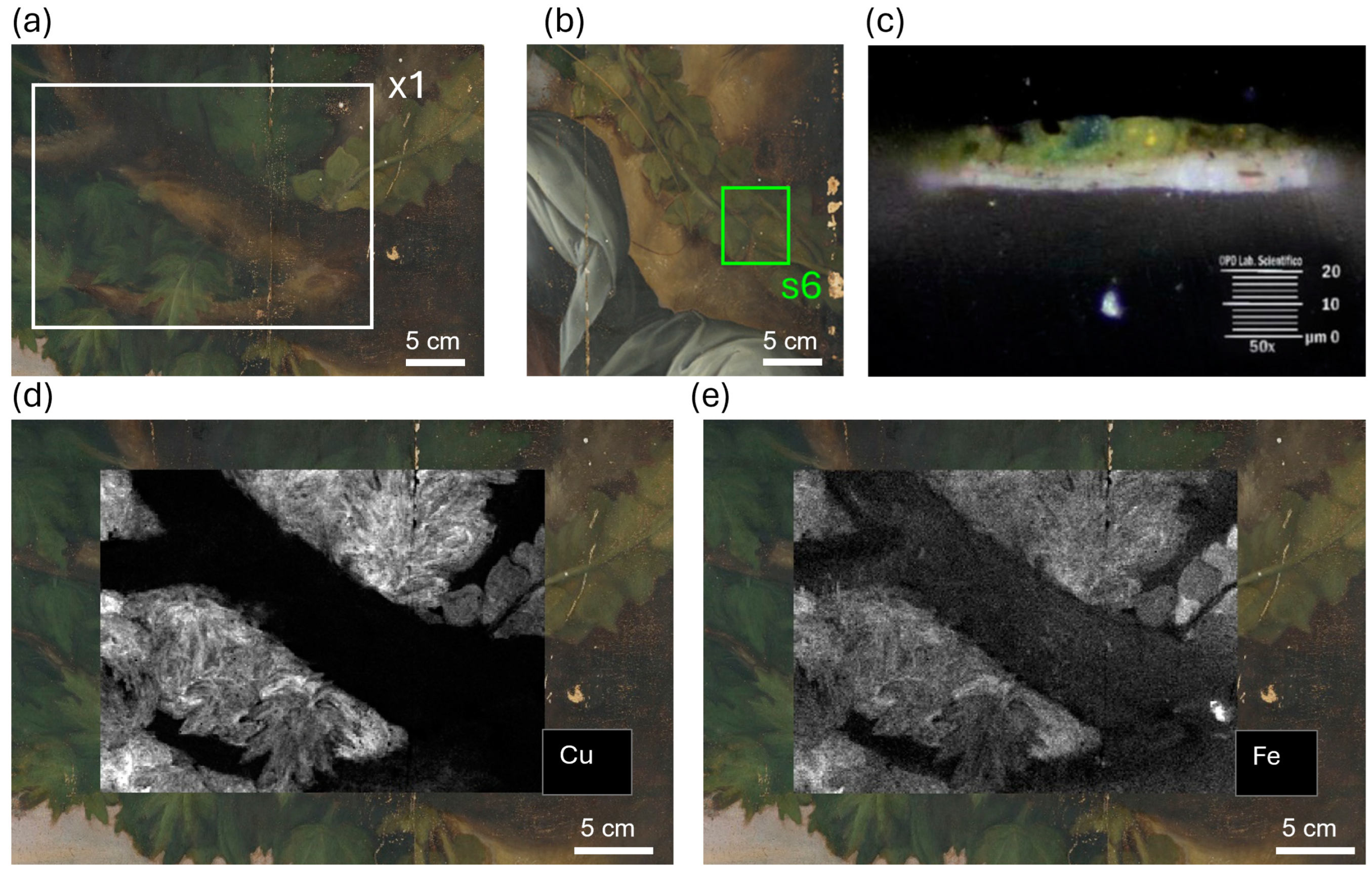
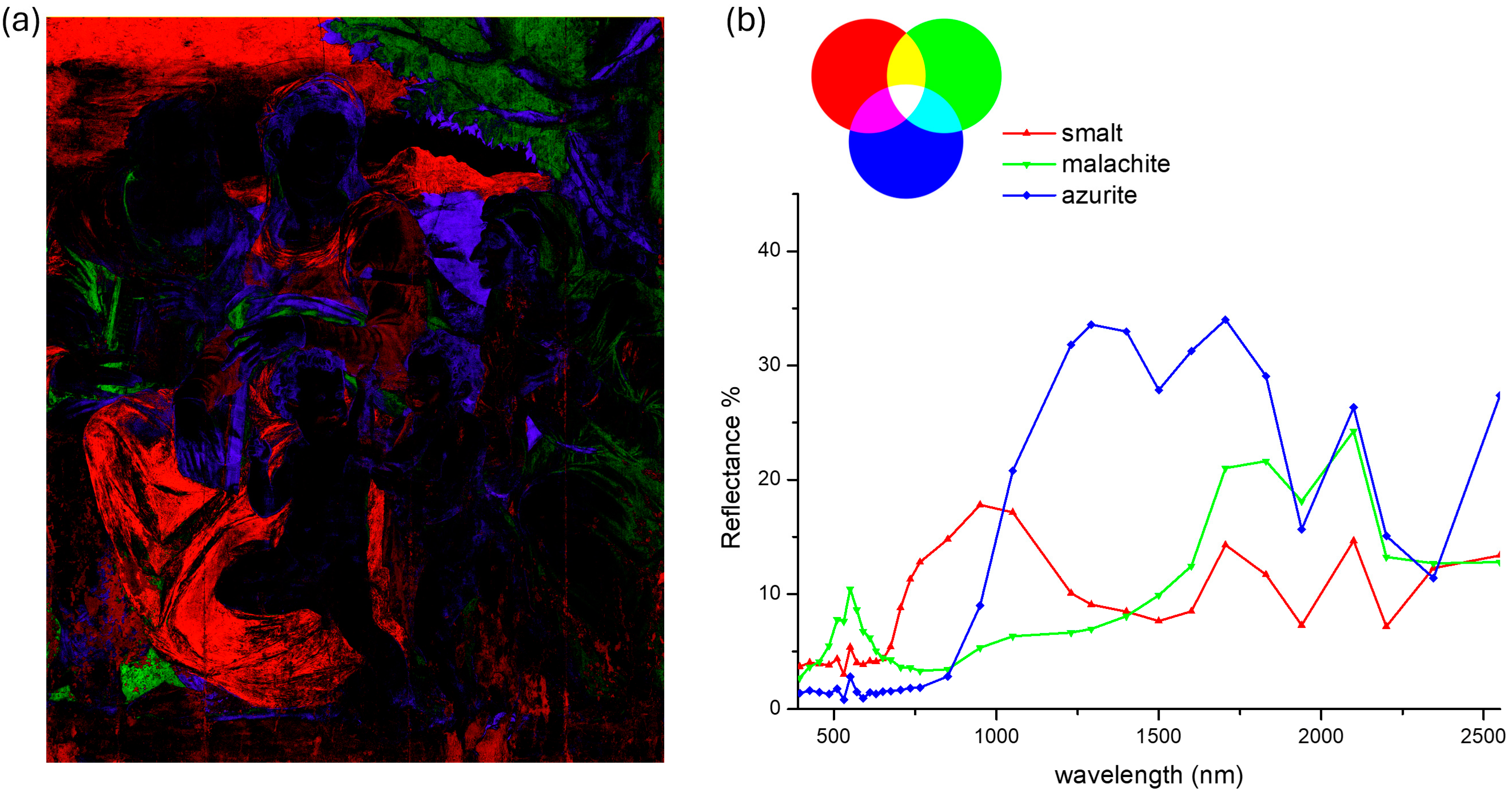


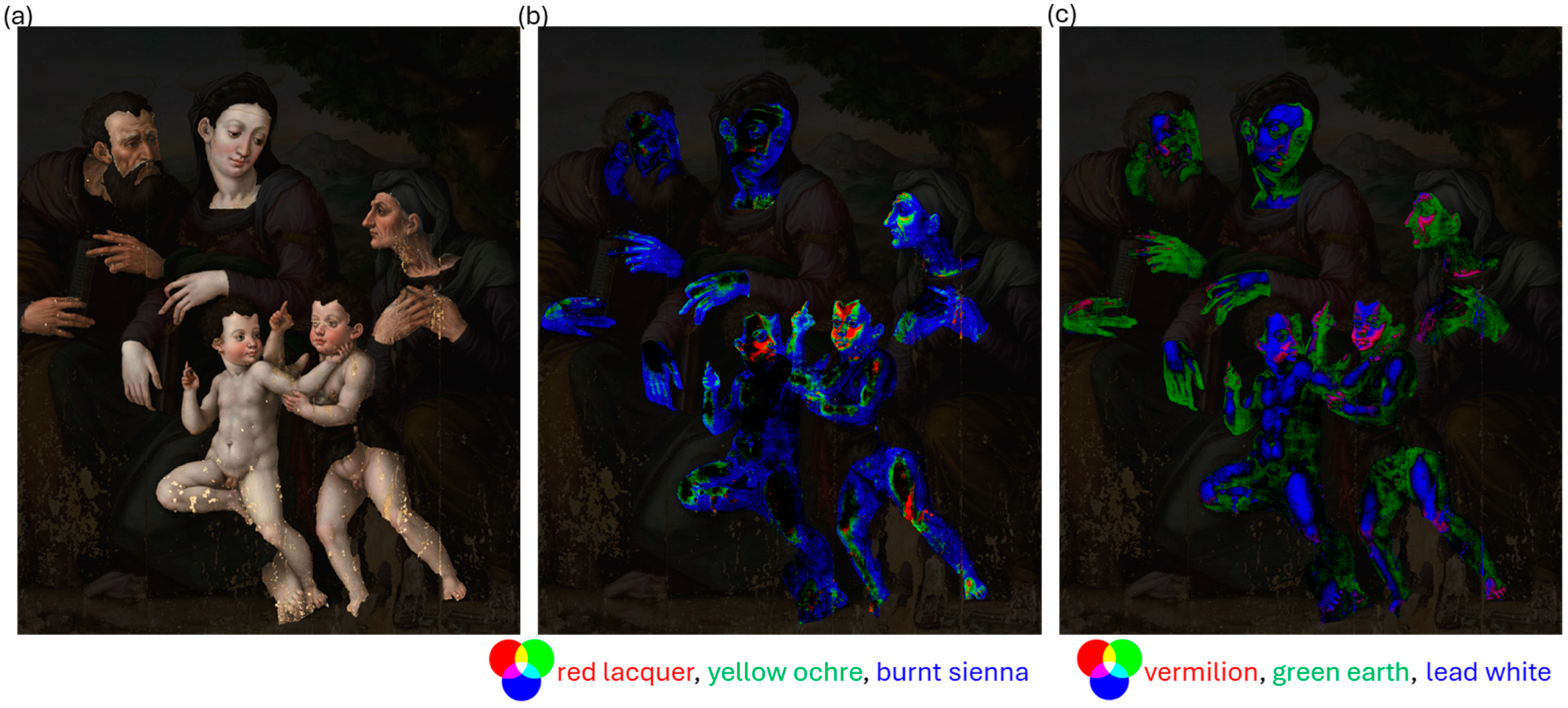


| Area | Hue | Elemental Analysis | Hypothesised Pigments | |
|---|---|---|---|---|
| St. Joseph | cloak (s1) | light pink | Pb, Si, Co, K, As *, Al | smalt, red lacquer |
| robe (x2) | yellow ochre | Fe, Pb | earth pigments, lead white | |
| Virgin | robe (s4, x2) | green blue | Si, Co, K, Fe, Co, Pb | smalt |
| dress (s2) | light pink | Pb, Al | red lacquer, lead white | |
| book (x2) | light purple (cover), yellow (pages) | Fe, Pb, Hg | earth pigments, lead white, vermilion | |
| St. Elizabeth | robe (s3) | dark yellow | Fe, Al, Si, Fe | earth pigments |
| flesh | Jesus Child (s5, x2), Virgin (x2) | skin tone | Pb, Fe, Hg, Mg * | lead white, vermilion, earth pigments |
| tree | branches (x1) | brown | Pb, Fe, Ca, K * | lead white, earth pigments |
| foliage (s6, x1) | green | Pb, Fe, Si, Cu | lead white, earth pigments, malachite/verdigris | |
| sky (x3) | bluish grey | Pb, Co, K, As *, Bi * | smalt, lead white | |
| Area | Hue | SC-Mapped Pigment Mixtures | |
|---|---|---|---|
| St. Joseph | cloak (s1) | light pink | smalt, red lacquer, vermilion, red ochre, yellow ochre, burnt sienna, lead white |
| mantle | bluish grey | carbon black/vine black, malachite, green earth, smalt | |
| robe (x2) | yellow ochre | green earth, yellow ochre, red ochre, burnt sienna, lead white | |
| book (cover) | dark red | red ochre, yellow ochre, burnt sienna, carbon black | |
| Virgin | robe (s4, x2) | green blue | smalt, carbon black, vine black, lead white |
| dress (s2) | light pink | vermilion, red ochre, red lacquer, yellow ochre, burnt sienna, indigo/lapis lazuli, lead white | |
| drapery | green | azurite, green earth, malachite | |
| book (x2) | light purple (cover) | burnt sienna, red ochre, lead white, vermilion | |
| yellow (pages) | burnt sienna, red ochre, copper green | ||
| St. Elizabeth | robe (s3) | dark yellow | earth pigments |
| dress | purple | carbon black/vine black, smalt, lead white | |
| veil | light grey | lead white, carbon black, vine black | |
| St. John child | scarf | red | red ochre, vermilion, carbon black/vine black |
| all figures | flesh (s5, x2) | skin tone | lead white, vermilion, green earth, red lacquer, yellow ochre, burnt sienna |
| tree | branches (x1) | brown | burnt sienna, green earth, copper green |
| foliage (s6, x1) | green | malachite, green earth, azurite, copper green, vine black | |
| background | sky (x3) | bluish grey | smalt, lead white, carbon black, yellow ochre |
| mountains | red ochre, yellow ochre, burnt sienna, lead white, smalt, indigo/lapis lazuli | ||
Disclaimer/Publisher’s Note: The statements, opinions and data contained in all publications are solely those of the individual author(s) and contributor(s) and not of MDPI and/or the editor(s). MDPI and/or the editor(s) disclaim responsibility for any injury to people or property resulting from any ideas, methods, instructions or products referred to in the content. |
© 2024 by the authors. Licensee MDPI, Basel, Switzerland. This article is an open access article distributed under the terms and conditions of the Creative Commons Attribution (CC BY) license (https://creativecommons.org/licenses/by/4.0/).
Share and Cite
Dal Fovo, A.; Morello, M.; Mazzinghi, A.; Toso, C.; Galeotti, M.; Fontana, R. Spectral Mapping Techniques for the Stratigraphic and Compositional Characterisation of a 16th-Century Painting. Heritage 2024, 7, 1320-1333. https://doi.org/10.3390/heritage7030063
Dal Fovo A, Morello M, Mazzinghi A, Toso C, Galeotti M, Fontana R. Spectral Mapping Techniques for the Stratigraphic and Compositional Characterisation of a 16th-Century Painting. Heritage. 2024; 7(3):1320-1333. https://doi.org/10.3390/heritage7030063
Chicago/Turabian StyleDal Fovo, Alice, Margherita Morello, Anna Mazzinghi, Caterina Toso, Monica Galeotti, and Raffaella Fontana. 2024. "Spectral Mapping Techniques for the Stratigraphic and Compositional Characterisation of a 16th-Century Painting" Heritage 7, no. 3: 1320-1333. https://doi.org/10.3390/heritage7030063
APA StyleDal Fovo, A., Morello, M., Mazzinghi, A., Toso, C., Galeotti, M., & Fontana, R. (2024). Spectral Mapping Techniques for the Stratigraphic and Compositional Characterisation of a 16th-Century Painting. Heritage, 7(3), 1320-1333. https://doi.org/10.3390/heritage7030063








